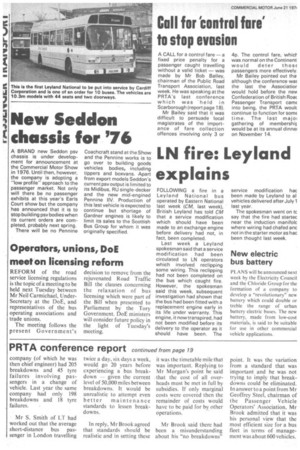Measuring the managers
Page 21

Page 22

If you've noticed an error in this article please click here to report it so we can fix it.
SOME POINTED comments about the need for measuring the efficiency of all levels of bus company staff were made by Mr Guy Neely, the NBC director of finance, during discussion on Mr Robert Brook's paper. Mr Neely was worried about methods of measuring efficiency getting out of hand and he questioned "with some diffidence" whether managers themselves were being measured correctly.
And the next speaker, Mr Tony Harrison, director. general of the Greater Man chester PTE, felt that measuring management efficiency was not very reasonable. He, for instance, did his best work in the bath.
He pleaded that targets should be set at realistic levels. It was impossible to completely eliminate vehicle breakdowns. However, a method of measurement was needed in order to compare different operations, and statistics were being studied. The industry should develop its own measures of efficiency rather than wait for local authorities to impose their own ideas.
Mr A. Beetham, author of the NBC's so-called Beetham Formula, described it as an initial step towards recognizing that operating costs were time and not mileage based. Further studies in conjunction with the Transport and Road Research Laboratory were taking place. Mr Ronald Cox, directorgeneral of the Greater Glasgow PTE, disagreed with Mr Brook's view that the operator should determine desired results and the level of waste. "My concept is that the person who pays must call the tune", he said. Thus the ultimate decision should be made by the passenger through his elected representative.
London Transport was currently developing a route-costing system to assist local authorities with determining the cost of individual services. Mr W. P. Morgan of LT revealed. Should subsidies cover only marginal costs or full, builtup costs? Very often the real measure of whether an undertaking was providing the service it should was the level of its staff recruitment and wastage. This was the reason for success or failure these days.
A qualitative change in attitude to public transport was forecast by Cllr S. Yapp, chairman of the West Midlands Metropolitan County Council. The existence of large councils could be in jeopardy if the results of TPP's were not accepted by the electorate.
Mr George McKay, the NBC's director of technical services, returning to the "no breakdowns" paragraph in the paper, said vehicle reliability was in fact getting better. In 1955, for example, the West Yorkshire company (of which he was then chief engineer) had 205 breakdowns and 45 tyre failures involving passengers in a change of vehicle. Last year the same company had only 198 breakdowns and 18 tyre failures.
Mr S. Smith of LT had worked out that the average short-distance bus passenger in London travelling twice a day, six days a week, would go 20 years before experiencing a bus breakdown given the current level of 50,000 miles between breakdowns. It would be unrealistic to attempt even better maintenance standards to lessen breakdowns.
In reply, Mr Brook agreed that standards should be realistic and in setting these it was the timetable mile that was important. Replying to Mr Morgan's point he said that the cost of all overheads must be met in full by subsidies. If only marginal costs were covered then the remainder of costs would have to be paid for by other operations.
Mr Brook said there had been a misunderstanding about his "no breakdowns" point. It was the variation from a standard that was important and he was not trying to imply that breakdowns could be eliminated. In answer to a point from Mr Geoffrey Steel, chairman of the Passenger Vehicle Operators' Association, Mr Brook admitted that it was his personal view that the most efficient size for a bus fleet in terms of management was about 600 vehicles.








































































































